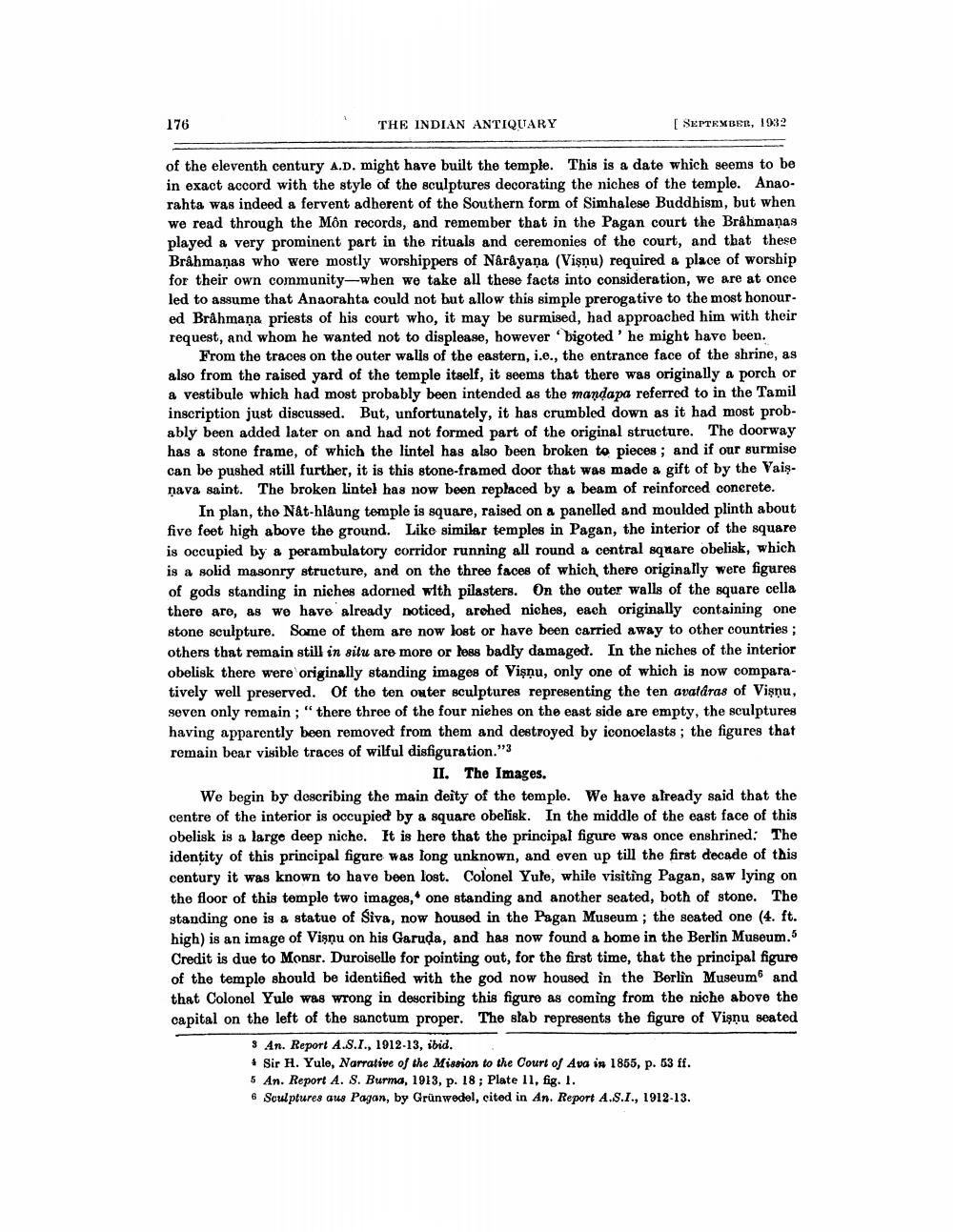________________
176
THE INDIAN ANTIQUARY
[ SEPTEMBER, 1932
of the eleventh century A.D. might have built the temple. This is a date which seems to be in exact accord with the style of the sculptures decorating the niches of the temple. Anaorahta was indeed a fervent adherent of the Southern form of Simhalese Buddhism, but when we read through the Môn records, and remember that in the Pagan court the Brâhmaņas played a very prominent part in the rituals and ceremonies of the court, and that these Brahmanas who were mostly worshippers of Narayana (Vişnu) required a place of worship for their own community-when we take all these facts into consideration, we are at once led to assume that Anaorahta could not but allow this simple prerogative to the most honour. ed Brahmaņa priests of his court who, it may be surmised, had approached him with their request, and whom he wanted not to displease, however bigoted' he might have been.
From the traces on the outer walls of the eastern, i.e., the entrance face of the shrine, as also from the raised yard of the temple itself, it seems that there was originally a porch or a vestibule which had most probably been intended as the mandapo referred to in the Tamil inscription just discussed. But, unfortunately, it has crumbled down as it had most probably been added later on and had not formed part of the original structure. The doorway has a stone frame, of which the lintel has also been broken to pieces ; and if our surmise can be pushed still further, it is this stone-framed door that was made a gift of by the Vaiş. nava saint. The broken lintel has now been replaced by a beam of reinforced concrete.
In plan, the Nat-hlâung temple is square, raised on a panelled and moulded plinth about five feet high above the ground. Like similar temples in Pagan, the interior of the square is occupied by a perambulatory corridor running all round a central square obelisk, which is a solid masonry structure, and on the three faces of which there originally were figures of gods standing in niches adorned with pilasters. On the outer walls of the square cella there are, as we have already noticed, arched niches, each originally containing one stone sculpture. Some of them are now lost or have been carried away to other countries; others that remain still in situ are more or less badly damaged. In the niches of the interior obelisk there were originally standing images of Vişnu, only one of which is now comparatively well preserved. Of the ten outer sculptures representing the ten avataras of Vişnu, seven only remain ; "there three of the four niehes on the east side are empty, the sculptures having apparently been removed from them and destroyed by iconoclasts; the figures that remain bear visible traces of wilful disfiguration."
II. The Images. We begin by describing the main deity of the temple. We have already said that the centre of the interior is occupied by a square obelisk. In the middle of the east face of this obelisk is a large deep niche. It is here that the principal figure was once enshrined: The identity of this principal figure was long unknown, and even up till the first decade of this century it was known to have been lost. Colonel Yule, while visiting Pagan, saw lying on the floor of this temple two images, one standing and another seated, both of stone. The standing one is a statue of Siva, now housed in the Pagan Museum ; the seated one (4. ft. high) is an image of Visnu on his Garuda, and has now found a home in the Berlin Museum.5 Credit is due to Monsr. Duroiselle for pointing out, for the first time, that the principal figure of the temple should be identified with the god now housed in the Berlin Museum and that Colonel Yule was wrong in describing this figure as coming from the niche above the capital on the left of the sanctum proper. The słab represents the figure of Vişnu seated
9 An. Report A.S.I., 1912-13, ibid. + Sir H. Yule, Narrative of the Mission to the Court of Ava in 1865, p. 63 ff. 5 An. Report A. S. Burma, 1913, p. 18; Plate 11, fig. 1. 6 Sculptures aus Pagan, by Grünwedel, cited in An. Report A.S.I., 1912-13.




